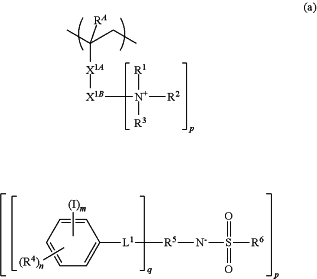| CPC G03F 7/0392 (2013.01) [G03F 7/0045 (2013.01); G03F 7/0048 (2013.01); G03F 7/0395 (2013.01); G03F 7/0397 (2013.01); G03F 7/70025 (2013.01); C08F 220/04 (2013.01); C08F 220/382 (2020.02)] | 12 Claims |
|
1. A positive resist composition comprising a base polymer comprising recurring units (a) having the structure of an ammonium salt of a sulfonamide having an iodized aromatic ring and recurring units of at least one type selected from recurring units (b1) having a carboxyl group substituted with an acid labile group and recurring units (b2) having a phenolic hydroxyl group substituted with an acid labile group,
wherein the recurring units (a) have the formula (a):
 wherein m is an integer of 1 to 5, n is an integer of 0 to 3, 1≤m+n≤5, p is 1 or 2, q is 1 or 2,
RA is hydrogen or methyl,
X1A is a single bond, ester bond or amide bond,
X1B is a single bond or a C1-C20 (p+1)-valent hydrocarbon group which may contain an ether bond, carbonyl moiety, ester bond, amide bond, sultone moiety, lactam moiety, carbonate bond, halogen, hydroxyl moiety or carboxyl moiety,
R1, R2 and R3 are each independently hydrogen, a C1-C12 alkyl group, C2-C12 alkenyl group, C6-C12 aryl group, or C7-C12 aralkyl group, R1 and R2, or R1 and X1B may bond together to form a ring with the nitrogen atom to which they are attached, the ring may contain oxygen, sulfur, nitrogen or a double bond,
R4 is a hydroxyl group, optionally halogenated C1-C6 saturated hydrocarbyl group, optionally halogenated C1-C6 saturated hydrocarbyloxy group, optionally halogenated C2-C7 saturated hydrocarbylcarbonyloxy group, optionally halogenated C2-C7 saturated hydrocarbyloxycarbonyl group, optionally halogenated C1-C4 saturated hydrocarbylsulfonyloxy group, fluorine, chlorine, bromine, amino, nitro, cyano, —N(R4A)—C(═O)—R4B, or —N(R4A)—C(═O)—O—R4B, R4A is hydrogen or a C1-C6 saturated hydrocarbyl group, R4B is a C1-C6 saturated hydrocarbyl group, C2-C8 unsaturated aliphatic hydrocarbyl group, C6-C14 aryl group or C7-C15 aralkyl group,
R5 is a C1-C10 (q+1)-valent hydrocarbon group,
R6 is a C1-C6 fluorinated saturated hydrocarbyl group or C6-C10 fluorinated aryl group, and
L1 is a single bond, ether bond, carbonyl group, ester bond, amide bond, carbonate bond, or C1-C20 hydrocarbylene group, the hydrocarbylene group may contain an ether bond, carbonyl moiety, ester bond, amide bond, sultone ring, lactam ring, carbonate bond, halogen, hydroxyl moiety or carboxyl moiety.
|